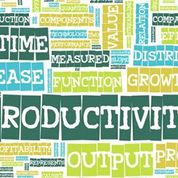The Need for Greater Productivity through Online Learning, Part 1
Published by: WCET | 1/21/2014
Tags: Competency-based Education, Completion, Cost Of Instruction, Innovation, Outcomes, Research, Retention, Student Success
Published by: WCET | 1/21/2014
Tags: Competency-based Education, Completion, Cost Of Instruction, Innovation, Outcomes, Research, Retention, Student Success
January 21, 2014
In some circles, online learning has become the panacea for increasing access and productivity in higher education. As distance education professionals, we’ve been comfortable with the access issue, but politicians have pulled us into the productivity mix without fully acknowledging the higher education quagmire that they have created or the fundamental changes required to address this issue in a systematic way. All too often, politicians are seeking easy answers where there are none.
Tony Bates is a scholar of distance, online, and open learning. He’s worked and researched these modes of instruction at the campus, provincial, national, and international levels. We invited him to summarize a very well-written series of blog posts that he recently published on the issue of online learning’s role as a possible solution in the productivity debate. We are pleased he agreed to do so. If we don’t study the issues and define the debate, others will do it for us.
Later this week, we will post the second in this two-part series. Thank you Tony!
Russ Poulin, WCET
PART 1: Main Concepts and Principles
Introduction
Over the last few months I have been doing a series of blog posts on my own site on this topic (for a full list, see the end of this post). In these two specially commissioned posts for the WCET Frontiers blog, I will summarize the main points raised in this series. In this post I focus on main concepts and principles; in the second post I discuss promising areas where online learning could improve the productivity of higher education.
Why is productivity an important issue for online learning?
There is growing pressure from politicians in particular to increase the productivity of the higher education system (see, for instance, the Ontario government’s ‘discussion paper on innovation to make our university and college system stronger’).
Now I don’t dispute the need for more productivity in the system. We’ve moved to a mass system of higher education, and the more people who access post-secondary education, the higher the cost for governments (and indirectly tax payers) where higher education is publicly funded. Productivity is all about getting the biggest bang possible for each buck spent, whether it comes from tuition fees or taxes. This is what students, parents, and the general taxpayer expects from an effective public higher education system.
To date, the system has generally coped with expansion by increasing class size, hiring more lower paid adjunct faculty, increasing the use of lowly paid graduate teaching assistants, and building more buildings. This has been not so much a deliberate strategy to increase productivity, but more like a creeping, unplanned and short-termed response to changing conditions.
Educational technology and productivity
Universities in the USA and Canada have invested heavily in educational technologies: not just learning management systems, lecture capture systems, and whiteboards and projectors, but in educational technology support staff, and the biggest but most hidden cost, the time of faculty learning how to use learning technologies then applying them. However, almost no-one within the system makes the argument that the investment in learning technologies is to increase productivity – to do so would mean the kiss of death for most learning technology initiatives.
I think it’s time we became a little more grown-up about this whole topic. The growth in post-secondary education is such that we will continue to need professors and instructors for as far as most of us can see into the future. What we should be looking at is how we can get more output from those that are in the system, without necessarily increasing the number of hours that they have to work. To do this, we need to stop fixating on costs alone, but start focusing more on processes (such as teaching methods) and output (such as learning outcomes), and how technology could be used to improve output.
The second point is that models from industry are unlikely to transfer easily to higher education. We need to build models or theories of productivity that fit well with the goals and purposes of education. But that shouldn’t mean that we abandon the idea of productivity – we just need to make sure it fits.
Some key concepts and principles
There is not space here for a full discussion of this topic (see: Productivity and online learning: a summary of the main concepts). Here is a summary of some of the basic concepts or ideas that need to be considered when trying to apply ‘productivity’ to online education or learning technologies.
Inputs and costs
Inputs in education can be measured in various ways, but money invested (or costs) is one convenient way of counting input. Although not without some problems, the measurement of input with regard to online learning is not conceptually difficult.
Outputs
It’s when we come to outputs that there are more difficulties. How do we measure output in education, and in particular how do we relate outputs to inputs? The Organization for Economic Co-operation and Development (OECD) and other agencies use measures such as participation rates, graduation rates, standardized tests, etc., but at a post-secondary level these measures are more difficult. For instance, how do you measure what students have learned and more particularly relate that to the mode of delivery such as classroom versus online? In particular, how do you measure the learning that matters most in higher education?
It’s important that any attempt to measure productivity in education takes account of the nature of learning, and the different views of what constitutes learning. For me, academic learning is a process by which learners develop increasingly deeper and more complex understanding, and above all a capacity for learning how to learn, within a particular subject domain or discipline. This means pushing beyond the superficial presentation and reproduction of information to students understanding what a subject discipline is really about, and behaving and thinking as a professional within that subject domain. My experience of teaching online leads me to believe strongly that this kind of teaching is not only possible but often achieved in online learning. The challenge though is to scale that kind of learning or rather to find ways of teaching online that enable such learning to be successful across large numbers at less cost.
There are likely to be strong disagreements about the definition of valid measures of output, and how to obtain and measure such outputs, which makes the discussion of productivity in education all that more difficult. Nevertheless, we cannot go on pretending there is no ‘output’ from higher education. We need to agree on some definitions of what constitutes output, and to find ways to validly and reliably measure such outputs.

Scale and scope
One way to increase productivity in industry is through economies of scale: a standardized product that can be replicated very cheaply. MOOCs are a good example of this in education. Once developed they can be made available to an infinite number of learners with no or little increase in marginal costs.
It is worth noting that ‘economies of scale’ are associated with an industrial economic model, but online learning is based on digital not manufacturing technologies. Economies of scope are more associated with post-industrial economies. Economies of scope enable many variations on a standard product to meet individual needs at a low marginal cost for each variation. An example from online learning would be a core curriculum with many optional routes through the material, using adaptive technologies that respond to the inputs from individual students in different ways, depending on the needs of the learner.
Replacement of labor by technology
A key way to improve productivity in the business world is to replace high cost labor with lower cost technology. Post-secondary education certainly has high cost labor, which constitutes a major part of total costs. There is great interest then among policy makers and politicians in the possibility of computer-based learning replacing high labor costs, which partly explains the excitement about MOOCs.
However, there will be no productivity gains by replacing labor (instructors) with technology (computer-based learning), unless outputs are maintained or improved. It is important then to examine carefully the current state of computer-based learning, to see in which parts of teaching and learning computers can effectively replace human instructors. There is also a deeper philosophical issue, which is whether certain aspects of teacher-learner relationships should be replaced by computers. Are there some parts of the educational process that need to remain ‘human’?
Process design and management
Another productivity issue is the efficient design and management of the processes by which ‘inputs’ are turned into ‘outputs.’ The more one can simplify and/or reduce the cost of ‘processing’, while maintaining or enhancing quality, the greater the productivity.
A key process in education is the method of teaching. If we consider for example the development of 21st century skills such as independent learning, this will be heavily influenced not just by the content being taught, but how the teacher designs and/or how learners conduct activities that enable learners to develop such skills. In online learning this is usually called course design. Course design in fact is a major ‘process’ by which the productivity of online learning can be increased.
Conclusion
These are all different ways to look at productivity within a system. It can be seen that it is not a trivial issue, but I still think it is a worthwhile effort to examine at least the potential for online learning to increase productivity, to clarify the issues in doing this, and to have a stab at defining those areas that look most promising, and perhaps even more importantly, identifying possible dangers in certain approaches to productivity.
In my next post I have a stab at identifying promising areas of productivity for online learning.
Tony Bates
Tony Bates Associates Ltd
The full set of posts on productivity and online learning:
Graphic and photos provided by Tony Bates.
6 replies on “The Need for Greater Productivity through Online Learning, Part 1”
Much of this material should be axiomatic. That it’s not is a problem.
Given so many approaches, some mix of output measurements should work. It won’t be easy, but it certainly can be done.
In the process area, I have one comment because I’m a scientist (Caltech & Columbia Univ. degrees plus former prof. at large university) and am currently working in science education. The typical, traditional science lab has real process issues, especially in general education courses. Students may spent three hours once or twice a week in expensive and scarce facilities using expensive equipment and materials with close supervision and gain little understanding of science because the labs were designed for science majors rather than the general population.
The usual technology fix here is the simulated lab, but these are artificial. Some, the procedural simulations, are often used to prepare students for the IRL labs and so add only marginally to the process while requiring money and student time. Others, the data simulations, simply do not expose students to the realities of science. Remote labs, a small but growing area, delivers data sets to students really are appropriate only for science majors.
The approach of videoed science labs with highly interactive software allowing students to collect their own data point-by-point has promise in enhancing the process learning science for general education science courses. Even a 50% substitution of online real labs with interactive data collection will substantially reduce time, money, and space requirements while improving safety.
Technology can improve process in many other ways, I’m sure. I just provide one example from my experience. There’s no reduction in the number of faculty, although fewer teaching assistants may be necessary for the same number of students. However, the big benefit for many HE institutions, especially CCs, will be the ability to increase enrollment without new capital outlays. This increased enrollment will add to the number of TAs (in 4-year institutions) and number of adjunct faculty. In short, everyone wins.
The “input” is smaller. The throughput is larger. The “output” is equal or better than what it is now. So, why is there not a stampede to this solution already?
[…] See on wcetblog.wordpress.com […]
[…] Click here to read this article. […]
[…] « The Need for Greater Productivity through Online Learning, Part 1 […]
[…] a guest post by noted educational technology thinker, Tony Bates. The first part focused on Main Concepts and Principles. Again, thank you to Tony Bates for his contribution.Russ Poulin, […]
[…] for providing his perspective on productivity and online education, including part 1 on “Main Concepts and Principles” and Part 2 on “Identifying Promising Areas of Productivity for Online […]